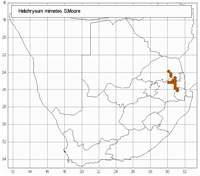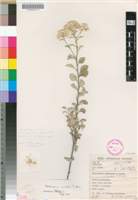Origin of name:
mimetes = imitator (Greek)
Diagnostic characters:
Leaves with distinct petioleOpen branched inflorescenceMedium sized headsCream bracts
Description:
Shrublet up to c. 600 mm high, branches thinly greyish-white tomentose, leafy. Leaves on coppice shoots and sappy growth ovate to subrotund, tapering to a petiole-like base, blade mostly 25�35 x 20�30 mm, apex very obtuse or rounded, mucronate, petiolar part c. 10�20 mm long, leaves on twigs often smaller, blade elliptic-ovate, ovate or subrotund, mostly 13�24 x 13�18 mm, becoming smaller and more distant upwards, petiolar part c. 6�10 mm long, base slightly expanded, half-clasping, upper surface of all leaves thinly grey-tomentose and glandular-puberulous beneath the wool, lower more densely tomentose. Heads homogamous, campanulate, c. 4�5 x 4�5 mm, c. 8 mm across the radiating bracts, many in corymbose clusters arranged in corymbose panicles. Involucral bracts in c. 5 series, graded, imbricate, inner slightly exceeding flowers, acute to obtuse, crisped, straw-coloured. Receptacle with fimbrils about equaling the ovaries. Flowers 16�24. Achenes not seen, ovaries glabrous. Pappus bristles many, scabrid, bases cohering by patent cilia.
Flowering mainly between May and September.
Distribution:
Favours rock outcrops and broken rocky cliffs. Endemic to Mpumalanga and W. Swaziland, ranging from Mariepskop and the Blyde River area to the Barberton Mountains, just entering Swaziland around Havelock and Pigg's Peak.
Grassland and Savanna Biomes.
Notes:
H. mimetes is easily confused with H. lepidissimum, but can be recognized by its decidedly grey leaves, persistently woolly on both surfaces and with flat margins; in H. lepidissimum the leaves tend to be green above (drying brown) because the wool is soon shed from the upper surface to reveal the underlying coarse shaggy hairs, and the leaf margins are crisped. H. mimetes can be distinguished from H. rudolfii by its graded, crisped, straw-coloured involucral bracts (not subequal, smooth, white). There is a difference in leaf shape too, but this is difficult to express in words.
All three species are sympatric and may grow in close proximity. It seems likely that the original material of H. mimetes was of hybrid origin: the leaves are more coarsely hairy above than is usual and the wool tends to be evanescent, so that the leaves are not distinctly grey; also, the leaf margins are very slightly crisped, Codd 1618 (NU; PRE) and Acocks 12865 (PRE), from the same site in the Barberton Mountains, somewhat resemble the type.
Taxonomy:
Literature:
Helichrysum mimetes S. Moore in J. Bot., Lond. 37: 322 (1899). Moeser in Bot. Jb. 44: 313 (1910).
Type:
Mpumalanga, Lydenburg distr., Spitzkop, Devil's Knuckles, Wilms 727 (BM, holo.).
Synonym(s):
Vouchers:
Codd 7827 (K; PRE); Compton 27825 (K; PRE); Moss 18861 (BM; J); Nixon s.n. (E; K; NU; PRE); Rogers 18714 (BM; J; PRE).

